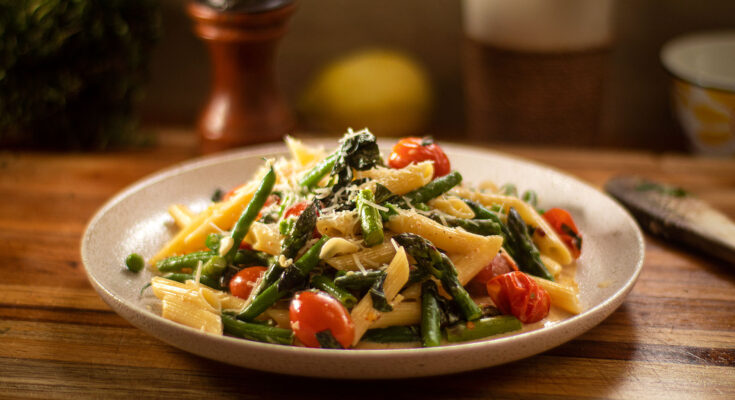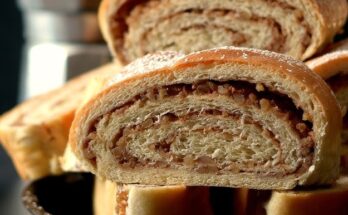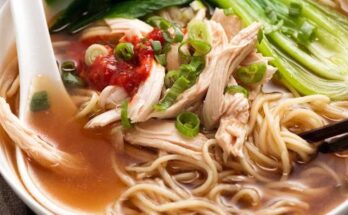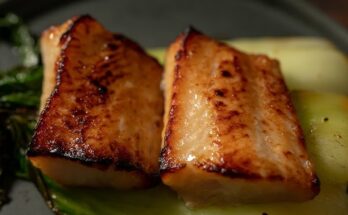Pasta Primavera Recipe: Pasta Primavera is one of those dishes that feels like a warm hug from the kitchen. Bursting with colorful vegetables, silky sauce, and perfectly cooked pasta, it’s a celebration of freshness and simplicity. The term “Primavera” means “spring” in Italian, reflecting the season when vibrant, tender veggies are at their best. However, this dish is delicious any time of the year — whether you’re craving something light for summer or a comforting bowl of pasta on a cozy evening.
Unlike heavy cream-based pastas like Alfredo, Pasta Primavera focuses on brightness and freshness. It’s all about letting the vegetables shine while complementing them with a delicate, flavorful sauce. What’s even better? It’s incredibly easy to make at home, even if you’re not a professional chef.
Imagine a bowl of perfectly al dente spaghetti, tossed with tender-crisp bell peppers, zucchini, cherry tomatoes, and a hint of garlic, all tied together with a light cream or olive oil-based sauce. The balance of textures and flavors makes it a crowd-pleaser for family dinners, date nights, or even meal prep for the week.
So, if you’re ready to bring the colors of spring right to your plate, let’s dive into the ultimate Pasta Primavera recipe — a dish that’s not just food, but an experience!
Ingredients You’ll Need
Before jumping into cooking, let’s gather everything you’ll need. Pasta Primavera is flexible, so you can customize it with your favorite vegetables or sauce. Still, here’s the classic ingredient list that delivers that perfect balance of flavors and textures.
Fresh Vegetables
- 1 small zucchini, sliced into thin half-moons
- 1 small yellow squash, sliced similarly
- 1 red bell pepper, julienned
- 1 yellow bell pepper, julienned
- 1 cup broccoli florets
- 1 cup cherry tomatoes, halved
- ½ cup snap peas or green beans
- 2 cloves garlic, minced
- 1 small carrot, thinly sliced
- Salt and pepper, to taste
Tip: Always choose firm, brightly colored vegetables. They should be crisp and fresh — that’s where all the flavor and nutrition come from.
Pasta Choices
The beauty of Pasta Primavera is that it works with almost any pasta shape.
- 12 oz spaghetti, fettuccine, or penne (whole wheat or gluten-free optional)
- Salted water, for boiling
If you love texture, penne and rotini hold the sauce beautifully, while spaghetti gives that classic Italian twirl.
Sauce Ingredients
For a light, creamy sauce that complements your veggies:
- 3 tablespoons olive oil or butter
- ½ cup heavy cream or half-and-half
- ¼ cup grated Parmesan cheese
- ½ teaspoon Italian seasoning
- ¼ teaspoon red chili flakes (optional for heat)
- 1 tablespoon lemon juice
- ½ cup vegetable or chicken broth
This combination brings richness without overpowering the vegetables, maintaining that fresh, spring-like flavor.
Optional Add-ins and Garnishes
- Grilled chicken or shrimp – for a protein-packed version
- Fresh basil or parsley – for garnish
- Extra Parmesan or Pecorino Romano – for a cheesy finish
- Toasted pine nuts – for crunch
These extras can take your Pasta Primavera from simple to restaurant-worthy in minutes!
Kitchen Equipment You’ll Need
Cooking Pasta Primavera doesn’t require fancy tools, but having the right equipment makes the process smoother. Here’s what you’ll need:
- A large pot for boiling pasta
- A large skillet or sauté pan for cooking vegetables
- A colander for draining pasta
- A sharp knife and cutting board for prepping veggies
- A wooden spoon or tongs for tossing pasta and sauce
- Measuring cups and spoons for accuracy
Optional but useful:
- Microplane grater for fresh Parmesan
- Zester for adding a hint of lemon zest
- Serving bowl to mix everything together beautifully
With everything prepped and ready, you’re set to start cooking!
Step-by-Step Guide to Making Pasta Primavera
Let’s bring all the ingredients together into one flavorful masterpiece. Follow these detailed steps carefully for the perfect homemade Pasta Primavera.
Step 1 – Prepare Your Ingredients
Gather your fresh ingredients: pasta (penne, fettuccine, or spaghetti), colorful vegetables like bell peppers, zucchini, cherry tomatoes, carrots, and broccoli, along with garlic, olive oil, grated parmesan, and cream or broth for the sauce. Wash and chop the vegetables into bite-sized pieces so they cook evenly and look vibrant in the dish.
Step 2 – Boil the Pasta Perfectly
Bring a large pot of salted water to a boil. Add the pasta and cook according to package directions until al dente — tender but still firm to the bite. Reserve about ½ cup of the pasta water before draining; you’ll use it later to adjust the sauce consistency.
Step 3 – Sauté the Vegetables
In a large skillet, heat a couple of tablespoons of olive oil over medium heat. Add minced garlic and cook for about 30 seconds until fragrant. Then, add the vegetables starting with the firmer ones (like carrots and broccoli) and finishing with softer ones (like zucchini and peppers). Sauté for 5–7 minutes until tender-crisp — they should stay colorful and slightly crunchy.
Step 4 – Make the Creamy Sauce
Reduce the heat slightly and pour in about ½ cup of cream or a mix of broth and cream. Add grated parmesan cheese and stir until the sauce thickens slightly. Season with salt, black pepper, and a sprinkle of Italian herbs. For a lighter version, you can skip the cream and use olive oil and lemon juice instead.
Step 5 – Combine Everything Together
Add the cooked pasta to the skillet with the vegetables. Toss everything gently until the pasta is well coated in the creamy sauce. If the sauce feels too thick, add a splash of the reserved pasta water to loosen it.
Serve hot, topped with extra parmesan, cracked black pepper, and a few fresh basil leaves. Bright, creamy, and full of garden-fresh goodness — Pasta Primavera is springtime in a bowl!
Tips for the Best Pasta Primavera
Every great cook has a few secrets up their sleeve, and these tips will help you make your Pasta Primavera taste like it came straight out of an Italian kitchen.
How to Choose the Freshest Vegetables
Fresh vegetables are the heart and soul of this dish, so quality matters. Always look for:
- Bright colors: Deep, rich hues mean your veggies are full of flavor and nutrients.
- Firm texture: Avoid anything soft, wrinkled, or dull.
- Seasonal picks: The fresher the produce, the better the taste. Spring and summer vegetables work wonderfully — zucchini, bell peppers, and tomatoes are all-stars here.
If you can, visit a local farmer’s market. The produce is usually fresher than what you’ll find in a supermarket and packed with natural sweetness.
Balancing Flavors and Textures
A perfect Pasta Primavera balances crisp vegetables, creamy sauce, and tender pasta.
Here’s how to achieve that harmony:
- Don’t overcook the vegetables — you want them slightly firm for texture.
- Use acidic ingredients like lemon juice or tomatoes to brighten up the creaminess.
- A dash of chili flakes or black pepper adds just the right amount of kick.
- Always taste and adjust — salt and acidity are your best friends in balancing flavor.
Lastly, don’t be afraid to personalize the dish! Pasta Primavera is forgiving and flexible, so feel free to mix and match vegetables based on what’s in season or what’s in your fridge.
Variations of Pasta Primavera
One of the best things about Pasta Primavera is how adaptable it is. Whether you’re vegan, gluten-free, or simply craving something new, you can tweak the recipe without losing its essence.
Vegan Pasta Primavera
To make it vegan-friendly:
- Replace heavy cream with coconut cream or cashew cream.
- Use vegan Parmesan or nutritional yeast for that cheesy flavor.
- Stick to olive oil instead of butter.
This version is light yet satisfying, with all the vibrant flavors of the original dish intact.
Protein-Boosted Primavera
If you prefer a heartier meal:
- Add grilled chicken, shrimp, or tofu for extra protein.
- You can also toss in chickpeas or white beans for a vegetarian protein boost.
A little extra protein turns your Pasta Primavera into a balanced, filling dinner that’s perfect after a long day.
Gluten-Free Primavera Option
Gluten-sensitive? No problem!
- Use gluten-free pasta made from rice, corn, or chickpeas.
- Make sure your sauce ingredients (like broth and seasonings) are certified gluten-free.
You’ll still get all the creamy, savory goodness without any compromise on flavor or texture.
How to Store and Reheat Pasta Primavera
Got leftovers? Lucky you! Pasta Primavera tastes just as good the next day if stored properly.
- Storage: Transfer cooled pasta to an airtight container and refrigerate for up to 3 days.
- Reheating: Warm it gently in a skillet over low heat. Add a splash of broth or milk to loosen the sauce. Avoid microwaving directly, as it can dry out the pasta and make the veggies mushy.
If you want to freeze it, skip the cheese and cream while cooking. Add them fresh when reheating — that way, the texture and flavor stay intact.
Serving Suggestions
Pasta Primavera is versatile, making it perfect for both casual dinners and elegant gatherings. You can serve it as a main course or as a side dish alongside grilled meats, fish, or roasted chicken. Its colorful appeal makes it ideal for dinner parties, family meals, or even Sunday brunches.
For a beautiful presentation, serve it in a wide, shallow bowl so the colors of the vegetables really pop. Garnish with a sprinkle of fresh basil leaves, a few shavings of Parmesan cheese, and a drizzle of extra virgin olive oil. You can even add a few toasted pine nuts for a touch of crunch.
If you’re hosting a dinner, pair Pasta Primavera with a crisp white wine like Sauvignon Blanc or Pinot Grigio. For non-alcoholic options, sparkling water with lemon slices or iced herbal tea complements the dish’s freshness perfectly.
For side pairings, consider:
- Garlic bread or bruschetta to soak up that creamy sauce.
- Caesar salad or arugula salad for a refreshing balance.
- Roasted vegetables or grilled asparagus for extra color and nutrients.
Whether you’re serving it for a quiet weeknight meal or a festive occasion, this dish always brings a touch of Italian charm to the table.
Common Mistakes to Avoid
Even though Pasta Primavera is a relatively simple recipe, a few common mistakes can affect the final result. Here’s how to avoid them and make your dish absolutely perfect every time.
- Overcooking the Vegetables
This is the most common mistake. Overcooked veggies lose their color, texture, and nutrients. Remember — you want them crisp-tender, not soggy. Always cook them quickly on high heat and remove them from the pan before they soften too much. - Overcooking the Pasta
Pasta should be cooked al dente — firm to the bite. It will continue cooking slightly when mixed with the sauce, so drain it just before it reaches perfect tenderness. - Skipping the Pasta Water
The starchy pasta water helps emulsify the sauce, giving it a silky texture that clings to the noodles. Always save about a cup before draining! - Using Too Much Cream or Cheese
Pasta Primavera should be light and fresh, not overly rich. The sauce should complement the vegetables, not drown them. Balance is key. - Not Seasoning Properly
Salt enhances every element of the dish — from the pasta to the sauce. Season your cooking water, vegetables, and sauce at every step for layered flavor. - Ignoring Fresh Ingredients
Using fresh herbs and vegetables makes a massive difference in taste and aroma. Avoid frozen veggies if possible — their texture tends to turn mushy after cooking.
Keep these simple rules in mind, and your Pasta Primavera will turn out bright, flavorful, and perfectly balanced every time.
Health Benefits of Pasta Primavera
Beyond its delicious flavor, Pasta Primavera packs an impressive nutritional punch. It’s one of those rare comfort foods that’s as nourishing as it is satisfying.
Here’s what makes it so good for you:
- Rich in Vitamins and Minerals: The colorful mix of vegetables — from zucchini to bell peppers — provides essential vitamins like A, C, and K, along with minerals such as potassium and magnesium.
- High in Fiber: The combination of vegetables and whole wheat pasta promotes healthy digestion and helps you stay full longer.
- Low in Saturated Fat: If you use olive oil and a light cream sauce, the dish stays heart-healthy and light.
- Balanced Macronutrients: With the right mix of carbs, fats, and proteins (especially if you add grilled chicken or shrimp), it’s a complete, balanced meal.
- Antioxidant Boost: The vibrant vegetables are loaded with antioxidants that help fight inflammation and support your immune system.
In short, Pasta Primavera isn’t just about flavor — it’s about feeling good after you eat it. It’s proof that comfort food can also be nutritious and wholesome.
FAQs about Pasta Primavera Recipe
1. Can I make Pasta Primavera ahead of time?
Yes! You can prepare the vegetables and sauce in advance, store them separately in the fridge, and toss everything together before serving. This way, the veggies stay fresh and crisp.
2. What is the best pasta type for this recipe?
Spaghetti and fettuccine are classic choices, but penne or rotini work well too since they hold the sauce beautifully.
3. Can I freeze Pasta Primavera?
Yes, but it’s best to freeze it without the cheese and cream. Add those after reheating to maintain the creamy texture and flavor.
4. How do I make Pasta Primavera spicier?
Simply add extra red chili flakes or a pinch of cayenne pepper while cooking the sauce. It adds a nice kick without overpowering the dish.
5. What can I serve with Pasta Primavera?
It pairs wonderfully with garlic bread, a green salad, or roasted vegetables. A light dessert like lemon sorbet makes a perfect finish.
Conclusion
Pasta Primavera is more than just a meal — it’s a celebration of color, flavor, and freshness. From the tender pasta to the crisp vegetables and the light, creamy sauce, every bite feels like a taste of spring. Whether you’re an experienced cook or a beginner in the kitchen, this recipe is easy to follow and incredibly rewarding.
The best part? It’s versatile. You can make it vegetarian, vegan, gluten-free, or protein-packed — it’s all up to your taste and dietary needs. With the right ingredients and a few simple techniques, you’ll have a dish that’s both nourishing and restaurant-worthy.
So the next time you want to bring some sunshine to your dinner table, whip up a bowl of homemade Pasta Primavera. It’s quick, comforting, and guaranteed to impress anyone you share it with.



